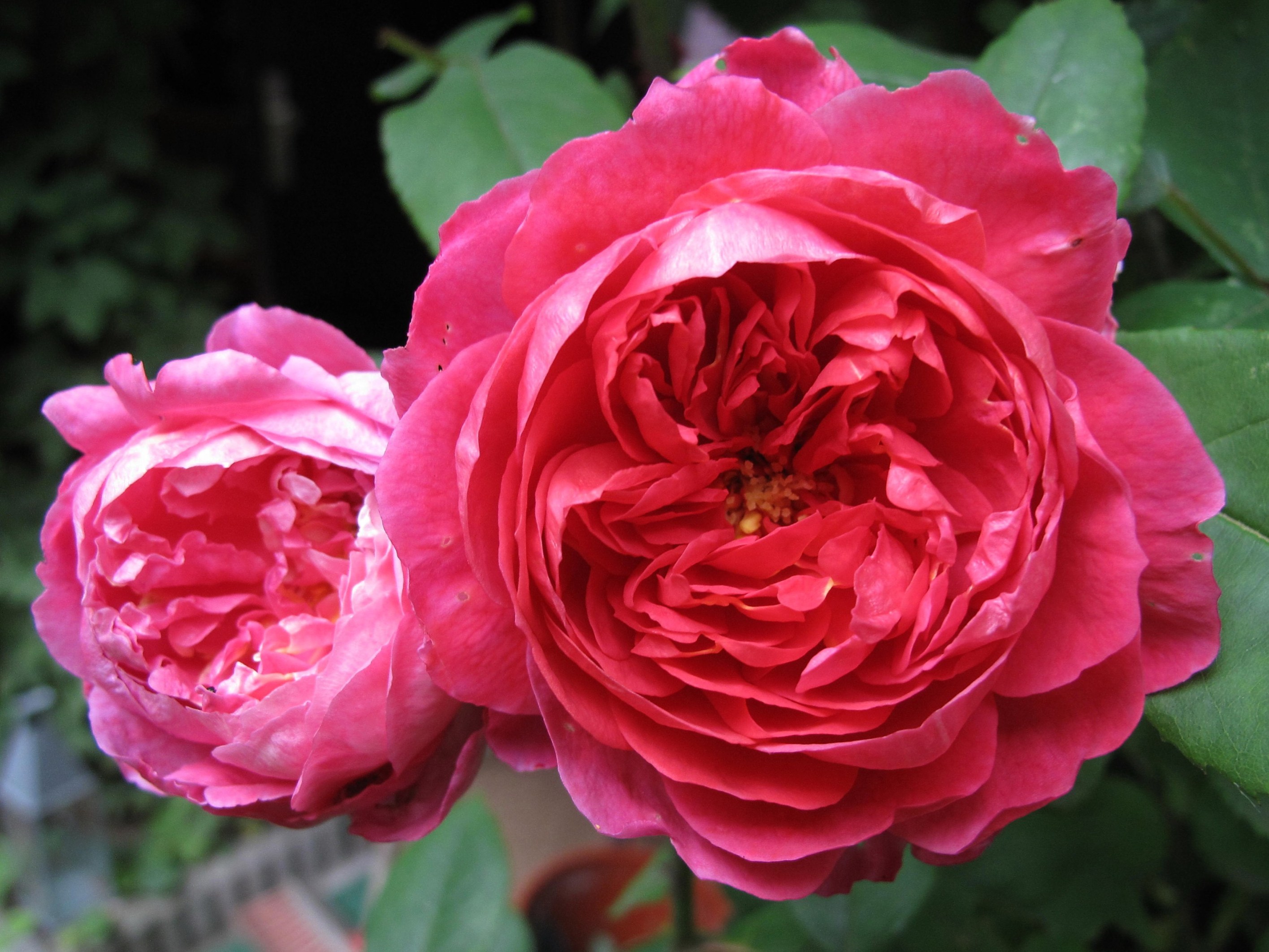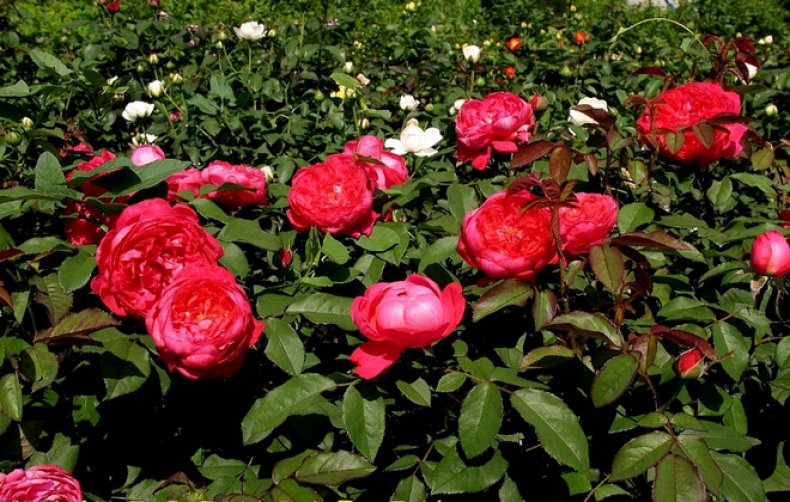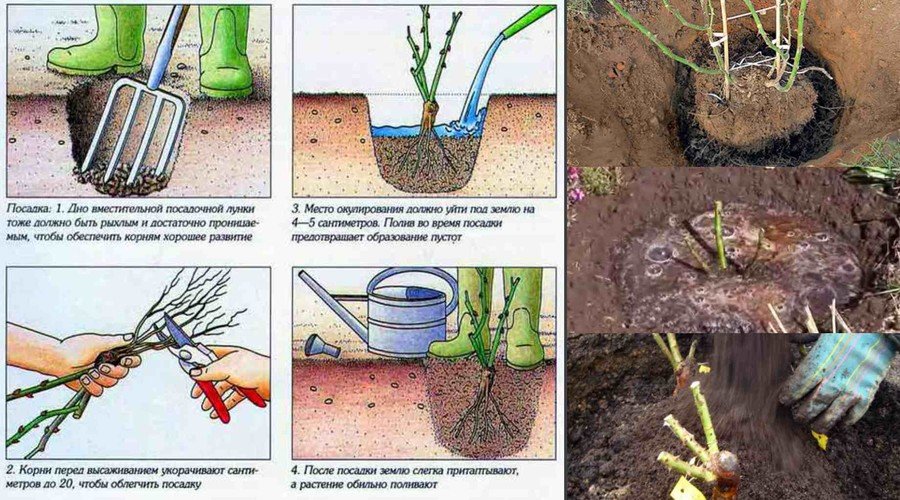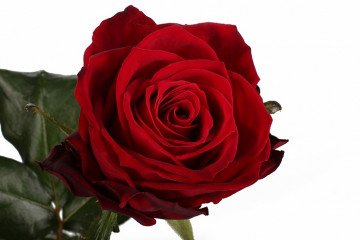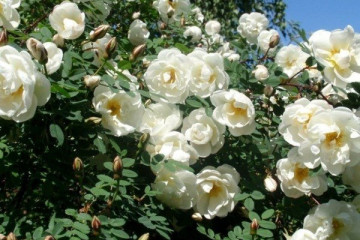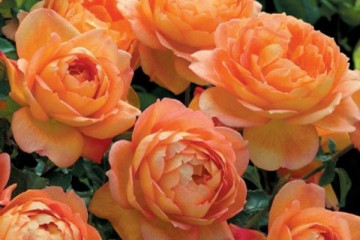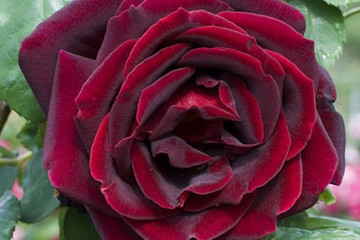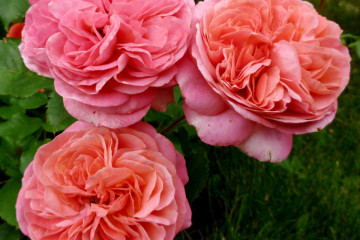Rose Benjamin Britten - description of the English variety
Content:
In 2001, British breeder D. Austin presented another selection masterpiece - the park variety Benjamin Britten. In 2005, the rose was awarded a certificate at a competition in Australia (Certificate of Merit, Australian National Rose Trials, 2005). Now it is actively cultivated by many summer residents and gardeners.
Variety history
The description says that the variety was named after a world famous, British musician E. B. Britten. The composer, conductor and pianist, according to the encyclopedia, founded the festival in Aldeborough and was the first to receive the E. Siemens Prize, which in the musical environment is similar to the Nobel Prize.
A characteristic feature of the variety is its bright scarlet color, as if illuminated from within. It is not typical for a group of English roses. D. Austin himself described it as a red brick, but the flower's palette is much richer. With age, he loses orange shades, they are replaced by a noble crimson.
The rose grows as a wide, branched bush, prone to thickening. Shoots are prickly, flexible. The foliage is light green semi-gloss. The open double flower (10-12 cm in diameter) has the shape of a deep bowl with bright yellow stamens in the middle. In the heat, the flower may become smaller.
The height of the bush largely depends on the place of growth. The declared dimensions are 90-100 cm in Russia, the Benjamin rose significantly outgrows.
Abundant flowering at the ends of the shoots at the beginning of summer is followed by a few brushes. This variety is well suited for cutting. The plant is powerful, unpretentious, beautifully combined with light varieties of English roses. The smell conveys notes of pear, caramel and wine.
English rose in landscape design
Austin Roses combine the nostalgic peony shape of old roses, a thick rich aroma with unpretentiousness and winter hardiness.
Roses bloom again during the season, three times in warm climates. Another feature that characterizes the vast majority of roses in this group is beautifully drooping shoots. The flowering of an adult English rose bush (from three years old) is mesmerizing. The bush is covered with flowers from top to bottom and attracts with aroma.
Since Austin roses are mostly classified as shrubs (park), they are used to create tall arrays, they look great next to conifers, herbaceous perennials. Combined in a rose garden can act as a background for hybrid tea roses and floribunda roses. In mono-planting, the manufacturer recommends planting at least four bushes in a checkerboard pattern.
Features of growing roses by David Austin
Plants can grow as a bush or climbing form (climber). It all depends on the specific variety and climate. The "Englishwomen" reveal their potential upon reaching three years from the moment of landing.
Landing
The petals are thin, delicate, do not tolerate high humidity and sunshine very well. For them, it is recommended to select a place taking into account light shading in the heat. A deaf shade leads to stretching of shoots and poor flowering.
Breeders recommend planting different varieties in groups, assuring that together they are harmoniously combined in color. To create a dramatic accent color, D.Austin suggests planting three bushes, keeping a distance of up to half a meter between them. In practice, this method has not justified itself. After 3-4 years, the size of the plants is such that it is not possible to care for them, and the bushes themselves oppress each other.
Further care
Caring for English roses is not difficult; standard procedures should be supplemented by cutting or cutting off faded buds. Not all roses are self-cleaning, shedding withered flowers, in addition, pruning stimulates the laying of new flower buds.
Watering
The regularity of watering is correlated with the season. In the spring, it is necessary to moisten the roots when the plant forms buds; in the heat, drying out of the soil can affect the growth and development of the bush. It is recommended to mulch the root area to keep the soil moisture comfortable for the plant longer. After rains, flowers, due to the abundance of petals, can rot from excess moisture, they need to be shaken so as not to lose flowering.
In order for watering to bring only benefits, you must adhere to the rules:
- water at the root, since moisturizing the foliage provokes the development of fungal diseases;
- once a week, in the absence of rain, pour a bucket of water under an adult plant;
- watering is stopped by the end of summer.
Top dressing
Adult roses require timely fertilization. "Englishwomen" are real workers - a 4-5-year-old bush produces about 200 flower buds and more in one flowering wave. In order for the plant to have enough strength, it is necessary to take care of nutrition throughout the season:
- with the awakening of the buds, nitrogenous fertilizers must be applied to the soil in order to stimulate the growth of roots and shoots;
- during the budding period, the plant needs potassium and phosphorus, as a rule, specialized complex fertilizers containing the necessary micro- and macroelements are used.
Pruning
Depending on the season, two types of pruning are performed:
- sanitary (in spring);
- formative (during the season).
With the arrival of spring, the bush must be prepared for flowering. Damaged, dried shoots are shortened to live wood (light cut with green edging). Thin, weak and growing inward branches are also cut out.
If the rose overwintered without loss, you can immediately proceed to formative pruning.
By purpose, pruning is divided into:
- strong (2/3). Used to stimulate the growth of lateral and basal shoots;
- moderate (1/2). Higher (1-3) shoots are left in the center, the lateral ones are shortened stepwise. Then flowering occurs at different levels, creating an overflowing effect;
- weak (1/3). In this case, the shoots are one third refreshing in young roses or bushes with a good shape.
Note! The shoot is cut at an angle that tends upward above the bud, which is directed from the center of the bush. The distance from it to the cut must be maintained 1.5-2 cm.
Wintering
D. Austin's roses are frost-hardy, tolerate winters well in a frame or frameless shelter. Autumn pruning is not desirable, leaves are cut off before shelter near the bushes, since fungal spores and pests hibernate on them, and bend down. Varieties with hard shoots are bent down in several stages.
Diseases and pests
Common diseases of English roses:
- powdery mildew;
- downy mildew;
- black spot;
- rust;
- gray rot;
- bacterial cancer.
Pathogens are bacteria and fungal spores that live in the soil and can enter the rose garden with an infected seedling.Plants are treated with soil and leaf treatments with systemic antifungal drugs. As a preventive measure, they are treated with Bordeaux liquid before the beginning of the growing season.
Pests:
- aphid;
- thrips;
- rose leaf roll;
- rose-colored sawfly;
- spider mite.
In this case, insecticides and acaricides will help; a number of treatments will be required to ward off insects.
Rose Benjamin Britten is a wonderful representative of Austin's Romantic Rose Gallery. Her presence will add charm to any garden, and cheerful, fragrant flowers will catch the eye.
